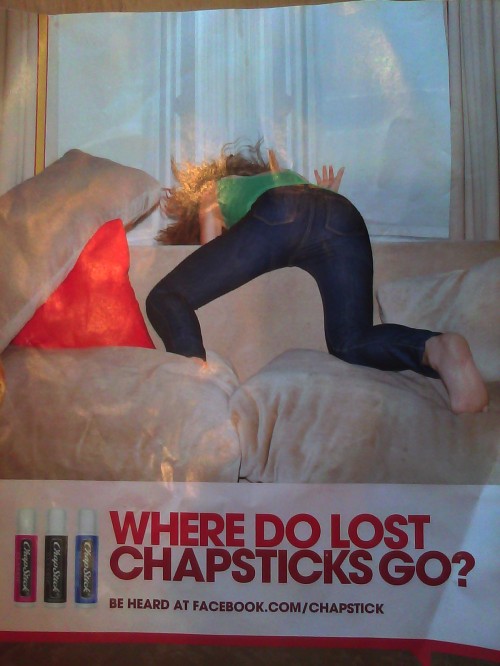When was the last time you bought Chapstick, anyway?

Is it possible you missed this week’s blogosphere scandal?
ChapStick posted the ad above, a couple of (female) bloggers decided it was sexist and offensive. Not a huge deal, except then ChapStick apparently started deleting negative comments about the issue from their Facebook page, which got everyone really upset.
Suddenly it was such a big deal that even Forbes and the Wall Street Journal – who couldn’t possibly be looking to cash in on the short-term traffic spike, could they? – felt it necessary to report on the issue. Adweek referred to the whole thing as a “death spiral“.
Please.
Samantha Ettus of Forbes said that the ChapStick brand has been built on the strength of female athletes like Suzy Caffee and Dorothy Hamill – but what she (and everyone else) seems to forget is that the lipcare marketplace has changed in the past 10+ years, and has changed a lot since the 1970s when Suzy Chapstick was first introduced.
An aging target market has a limited lifespan
It’s great if you can keep the customers you acquired in the 1970s, but ChapStick has a problem, which is, interestingly, contained within one of the offended bloggers’ posts:
“I have used your brand for 25 years, ever since my mom put my very first tube of ChapStick in the bib pocket of my snowpants before heading out for an afternoon of sledding….I have used your brand on my own children….”
Her kids may be using ChapStick now, but you know what’s going to happen: As soon as they can buy their own lip balm, they’ll reject what Mum bought them and head for more ‘adult’ lip balms.
That’s exactly what’s happened to ChapStick: While the lip balm category has grown by 12%, ChapStick sales have fallen by 2.6%, while newer, ‘cooler’ brands like Burt’s Bees have grown by double digits.
(And that doesn’t include the lip gloss revolution. Ask any girl or woman under 30 and she’ll tell you she’s got a lip gloss stockpile that far outpaces her lip balm collection.)
You can only coast for so long on squeaky-clean sports figures.
“I kissed a girl”, and other ways to make ChapStick more interesting
Some sources have suggested that Katy Perry’s Cherry ChapStick shoutout in her “I Kissed a Girl” song triggered sales increases of 50% for cherry ChapStick. And it wasn’t like that song was without controversy.
So you’re a marketing strategist for ChapStick. You see that being associated with older sportswomen is leading to shrinking sales, but being associated with pop culture is getting you more attention than you’ve had in years.
What do you do? Continue with the status quo advertising you’ve been doing since the 1970s, or try something a little different?
Right.
To be honest, I have no problems with the advertisement above. I don’t find it sexist (I’m far more offended by popstars and their ubiquitous naked body parts), and I happen to think it’s clever (because aren’t we all finding tubes of lip balm in odd places, 2 years after we lost them?).
More importantly, I think ChapStick has actually been pretty savvy here: The strategy (“Where do lost ChapSticks go?”) is a good one for appealing to new consumers without alienating existing ones, and has a lot of legs.
No, they shouldn’t have deleted comments from their Facebook page – censoring social media is always bound to get you in trouble – but in the long run I think the whole tempest in a teapot will go unnoticed by most of the target market, while giving them some much-needed top-of-mind awareness.
